Who have your teachers been?
My first formative teacher was in my adolescence. Thomas Lavinia was a very structured and caring teacher who ran a serious studio in my high school. Thanks to his 3-year tutelage, I learned all the basics of the ceramic studio as well as an appreciation of what was possible with clay.
Syracuse University was my next big learning period in the mid eighties; there was intense movement at that time; David MacDonald, Margie Hughto, and Jessica Feldheim were among those who taught and influenced me. I can remember spending hours in the old enormous ceramic building off campus in the evenings.
Europe followed where I spent almost 6 years, two in France and four in Berlin, Germany. I was a student at L`Ecole des Arts Dècoratif in Strasbourg and later in a private studio in Paris. I moved on to Berlin, Germany in 1989 where I worked at the Bilderhaurwerkstatt, (a studio for large scale sculptural projects).
Mexico, and more precisely, Santo Domingo, Ocotitlan, has been my permanent home and place of work for the past 22 years. In Morelos I have had the opportunity to study murals and tiles with the late Hugo Velasquez, and also with Aurora Suarez who guided me through the science of glazing.
Tell me about your trip and your contact with China. Can you speak a bit about this?
My trip to China was about porcelain and self -discovery. I spent two months in Jingdezhen, in the Jiangxi province, about 600 kilometers south of Shanghai. The city of Jingdezhen has a tradition that goes back a millennium as an international center for porcelain production. The economy of the city is still porcelain and it is still a meeting place between artist and craftsmen. There are many branches of expertise required to produce a beautiful porcelain object; painters, mold makers, brush and tool makers, tile makers, wheel throwers, decal printing, clay preparation and finally my personal favorites the firemen who can read a kiln by intensity, sound, feeling and color of the flame.
My quotidian was an intense period at a very special studio in Sanbao, countryside just beyond the city limits. It is a relaxed but highly cultivated artist center whose architect and founder is Li JianShen, or (Jackson Lee) as he calls himself in the West. Dedicated to ceramics and painting, it has kilns of every shape and size, including a long wood fired dragon kiln that winds its way up the mountain.
In the strangest way, China brought me back to Mexico. I can remember traveling in the Yunnan province with Jackson and feeling that I could be in a market place in Mexico. This trip opened up my horizons. I have a great desire to return to this place, and to my friends, and to share with them Mexico and its and small clay villages and markets. Both countries still have ancient cultures and tongues. Traditions and crafts are on the verge of disappearing in both places if we do not cherish, protect and cultivate a mature and responsible appreciation for them. China left me with this food for thought.
Many of the pieces are made up of volumes and dimensions that make us think in a corporal nature and a deep sensual relationship with the pieces. Do you find sensuality in your work?
Yes, absolutely. It is a wonderful energy to feel and to work with. I want to excite with boldness, color, texture. I want to build objects that invite touch. I want to move something dormant inside by working not only with my hands and head, but with my heart.
I don`t think I would still be making pots if I didn`t feel this kind of sensual connection to them. The pot is made up of the interior as well as the exterior spaces. There are vessels that open wide and others that close tightly; vessels that fit one into another. There is a connection to what is so human and what is so intimate. Vessels take a space and at the same time have resonances to a deep inner silence.
How did it occur to you to reach an installation in the space? It seems to me very apropro to use the convent as a stage. It seems dreamlike and is well resolved. How did you arrive to “Pour Memory”?
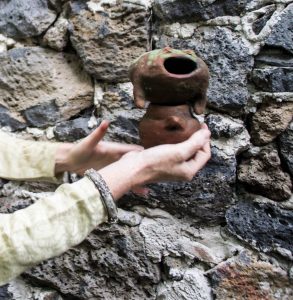 What hasn`t happened around a table in the history of man? It is the place of human connection and disconnection. It is the place where the sum of its parts gives strength, or does not. The wine is as good as the company you are sharing it with. The table becomes a three dimensional canvas, exactly…a stage as you say. It was a space that took form in context of the architecture of this historical building. “Pour Memory” is a jumbling of stories on a table.
What hasn`t happened around a table in the history of man? It is the place of human connection and disconnection. It is the place where the sum of its parts gives strength, or does not. The wine is as good as the company you are sharing it with. The table becomes a three dimensional canvas, exactly…a stage as you say. It was a space that took form in context of the architecture of this historical building. “Pour Memory” is a jumbling of stories on a table.
I was in a hurry on that foggy morning when I opened the oven door, everything seemingly intact. I went to Mexico City for the day, returning that same evening tired and with the weight of the world on my shoulders. I opened my kiln alone in the dark to find that those two bottles that had earlier seemed fine, had lost their bottoms. Deceptively whole, but on closer inspection, not. I decided to continue with these “broken” bottles, glazing them both. In the second firing the turquoise copper bottle keeled to one side, like a shipwreck. I had all these elements before me; more than 30 handbuilt smoke fired goblets, bottles with a “history”, and the 16th century convent. I must admit to stumbling wildly onto this table setting.
“Pour Memory” came into being about three days before the exhibition opened, in the form of a dream. This piece is a form of personal purification, touching upon something private. They say that dreams are a form of healing. A way for our minds to re – circuit and adjust themselves. “Pour Memory” placed in this space, in this historical building, took off on its own and a whole other meaning much more vast than something personal took hold.
What do you think about your work? Do you have a process of abstraction and concentration that takes you to a level of meditation. How do your forms appear?
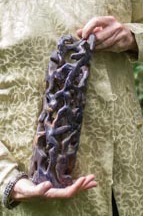 Oh goodness Itala I guess it just depends on the day. We all deal with the mundane don`t we? It is the moments when those cumbersome thoughts slip away, that the best work comes. For many years I have built vessels with coils, and this pace and way of building is propitious for reflection and the careful definition of the form in gestation.
Oh goodness Itala I guess it just depends on the day. We all deal with the mundane don`t we? It is the moments when those cumbersome thoughts slip away, that the best work comes. For many years I have built vessels with coils, and this pace and way of building is propitious for reflection and the careful definition of the form in gestation.
The proportion, the relation between its parts, the form and its curves as well as the contour of the piece is decided in harmony with the material and with my creative intention. Much of my inspiration comes from nature and I am constantly attentive to the smallest details. Textures, light, the “silence.” Life is being lived on all levels; it is a matter of opening up the lines of communication.
When I put clay in the kiln, I give it over to an environment of fire and melting oxides, and those complex chemical reactions touch and change. The constant surprises of the kiln are the avenues I find the most interesting to pursue.
I believe that my responsibility as an artist is the act of nurturing mysteries. If I can somehow fashion my intangible feelings into form, into clay, than that is what will give honesty and strength to my work. If I can share and touch others, the circle is complete.
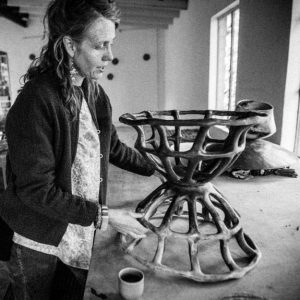 Clay has always been enough. Fate perhaps has had its say. I was given a plastic throwing wheel as a child and can remember throwing heavy lopsided pots in the basement. I have been working in ceramics for almost 30 years now, piece by piece, pot by pot, kiln by kiln. Ceramics has given me a way to measure my life, in terms of time, in stages, by what I am producing, the why, when, where and how. Through clay I have slowly stumbled upon myself and in turn, my own way of expressing what I feel deep inside.
Clay has always been enough. Fate perhaps has had its say. I was given a plastic throwing wheel as a child and can remember throwing heavy lopsided pots in the basement. I have been working in ceramics for almost 30 years now, piece by piece, pot by pot, kiln by kiln. Ceramics has given me a way to measure my life, in terms of time, in stages, by what I am producing, the why, when, where and how. Through clay I have slowly stumbled upon myself and in turn, my own way of expressing what I feel deep inside.
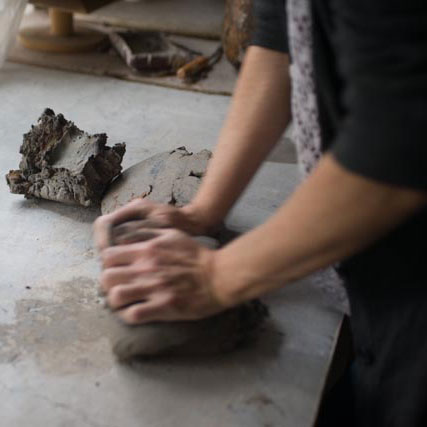

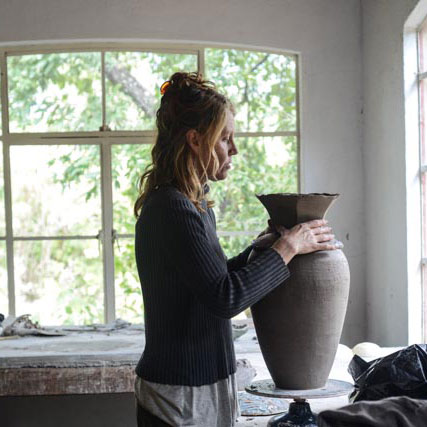
 What hasn`t happened around a table in the history of man? It is the place of human connection and disconnection. It is the place where the sum of its parts gives strength, or does not. The wine is as good as the company you are sharing it with. The table becomes a three dimensional canvas, exactly…a stage as you say. It was a space that took form in context of the architecture of this historical building. “Pour Memory” is a jumbling of stories on a table.
What hasn`t happened around a table in the history of man? It is the place of human connection and disconnection. It is the place where the sum of its parts gives strength, or does not. The wine is as good as the company you are sharing it with. The table becomes a three dimensional canvas, exactly…a stage as you say. It was a space that took form in context of the architecture of this historical building. “Pour Memory” is a jumbling of stories on a table. Oh goodness Itala I guess it just depends on the day. We all deal with the mundane don`t we? It is the moments when those cumbersome thoughts slip away, that the best work comes. For many years I have built vessels with coils, and this pace and way of building is propitious for reflection and the careful definition of the form in gestation.
Oh goodness Itala I guess it just depends on the day. We all deal with the mundane don`t we? It is the moments when those cumbersome thoughts slip away, that the best work comes. For many years I have built vessels with coils, and this pace and way of building is propitious for reflection and the careful definition of the form in gestation.